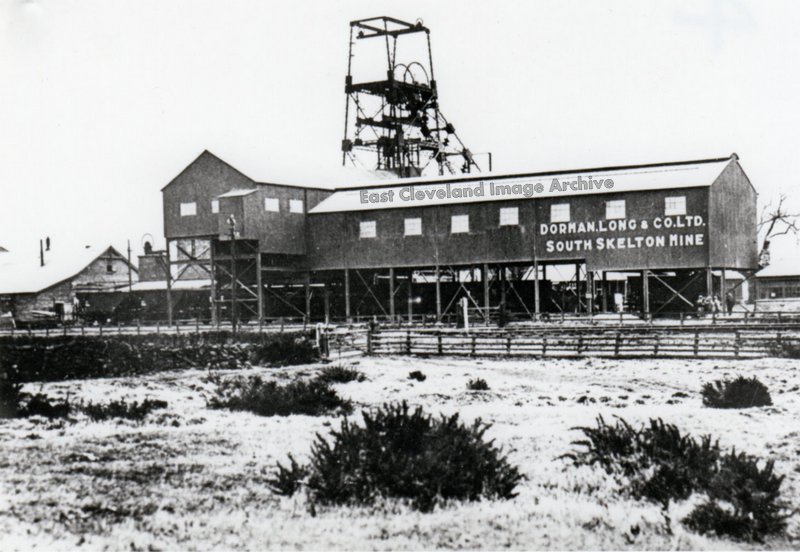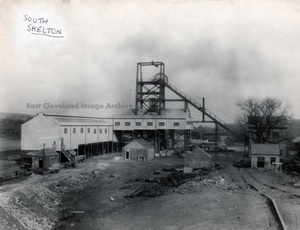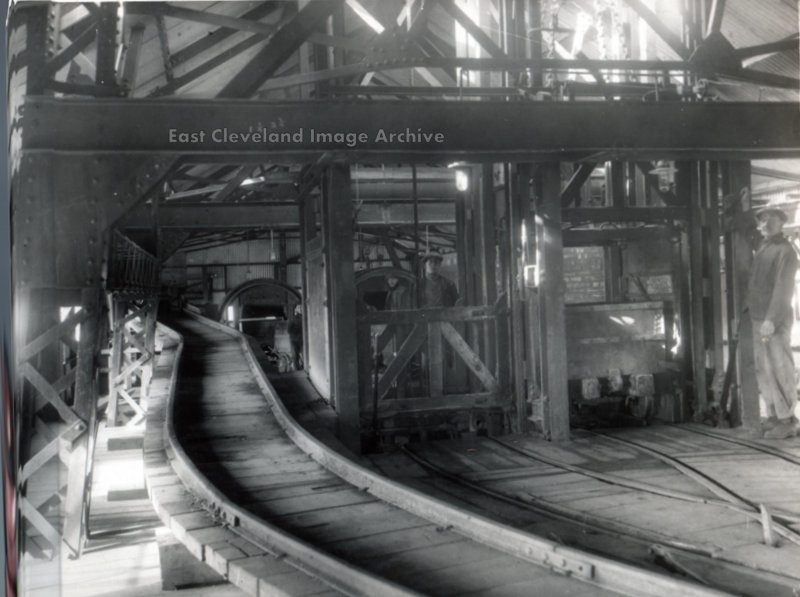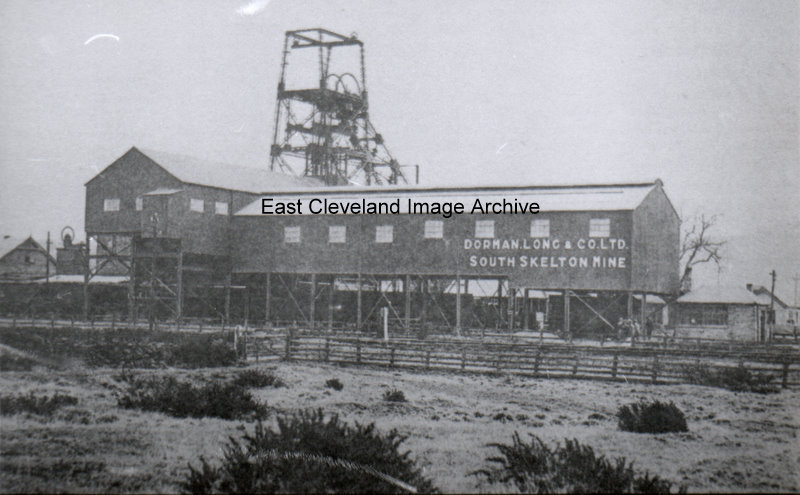
South Skelton Mine, around the time of closure in 1954. Mining commenced
in the 1860’s, at a depth of about 200 feet.
Image courtesy of George Pearson.
|
|
||
 South Skelton Mine, around the time of closure in 1954. Mining commenced Image courtesy of George Pearson.  South Skelton Mine just before the war, the Picking Belt shed at the left of the photograph looks fairly new; it was installed around 1935. The picking belt came from the redundant Belmont Mine. Image courtesy of George Pearson.  This photograph showing the arrangement at the top of the shaft at South Skelton Mine. On the right hand cage an empty tub waits to be lowered down the shaft. The man on the side of the cage appears to have his hand on a signalling handle which will send the right hand cage down and the left hand cage will raise a loaded tub to the surface. In the background the full tub from the left hand cage is being put into the tippler unit, which will turn the tub upside down and drop the contents onto the picking belt for sorting the shale from the stone. Any further information or corrections will be welcome. Image courtesy of George Pearson.  Well I couldn’t go wrong with this photograph could I? The name of the mine and the owners in plain sight on the building. The mine was situated close to Boosbeck and closed in 1954. Image courtesy of Eric Johnson.
South Skelton Pit (or Van’s Pit as it was locally known – after the owner – Thomas Vaughan) is sited between Boosbeck and Margrove Park. A nicely compact pit, this image shows the winding shaft and engine house built over and onto the heapstead. The two strange dovecot-type structures in the centre foreground are horse-gins used for working the winding shaft when engineering work was required below. Not much remains today, the mine manager’s house, two overmen’s houses, the stables and the engine house are about all I can bring to mind. The shale heap at Margrove Ponds Nature Reserve was waste from the mine and the pond itself was caused by subsidence from the mine. Image courtesy of the Pem Holliday Collection.
South Skelton mine is shown in the image and Simon Chapman advised us: “The mine was electrified 1912 – 1914, so the picture was taken before those dates.”. Image courtesy of Mike Holliday and thanks to Simon Chapman for the update.
”South Skelton Mine – 2nd December 1903” is the information this image; however Eric Johnson advises: ”Three of the men are holding carpentry tools; wood plane, large saw and set square. The front row are sitting on a plank between two saw “horses” (benches). They maybe joiners, tub repairers etc., also on the front row some men appear to be wearing oilskins (shaft workers ??). Simon Chapman’s book ”South Skelton Mine” has a photograph contemporary with this dated 6 days after this image”. Any more information would be welcomed. Image courtesy of Cleveland Ironstone Mining Museum.
I’m guessing a bit here, but there’s a fair-cross section of society depicted, so I reckon this is the mine manager with his management team. The man seated on the right with the walking stick has a shot cannister under his arm. Can somebody could supply names we’d get a better picture? Image courtesy of Cleveland Ironstone Mining Museum.
Now sadly painted over the former Police Station standing at the western end of Skelton High Street was a magnificent Victorian brick building; the Police Station was purchased from Skelton Castle Estate in 1921 by the then North Riding Constabulary. Bulmer’s Directory of 1890 lists Thomas Imeson as the Police Sergeant resident at the building; Kelly’s Directory of 1909 lists: “Sergeant Richard Benjamin Gamble + one Constable”, the building was superseded by a modern purpose-built building on Derwent Road in the late 1950s and subsequently closed. This postcard view shows a quieter road, the lady can push her pram up the near side of the road without risk; no thundering traffic then! Peter Appleton has further advised: “The old Police Station, more properly 1 South Terrace, is first recorded in the Skelton Castle Estates Rent book for Lady Day 1873 (25th March 1873) when a payment of £27.10s.0d was recorded. The entry bore the annotation “New”. The police presence there can be traced through successive censuses 1881-1911. The property was sold to the North Riding County Council in April 1921 for £620. The North Riding County Council sold the building in July 1963 to a Mr A E Danks. The police presence in Skelton, which started in August 1862, is described in more detail in my book: My Grandad was a “Felon”, pp 62-4” Image and update courtesy of Peter Appleton.
This postcard view of a building which will be remembered by many; internally it bears no resemblance to those views included in this image and externally is passed by many who are unaware of the buildings former essential use. Originally opened on 26th December 1913, for the Skelton Territorials “G” Company of the 4th Yorkshire Regiment, in the 1960s it became a social club. After burning down it was altered into apartments, bearing the title of Marlborough Court; it still stands at the southern end of Marlborough Road. |
||
Recent Comments